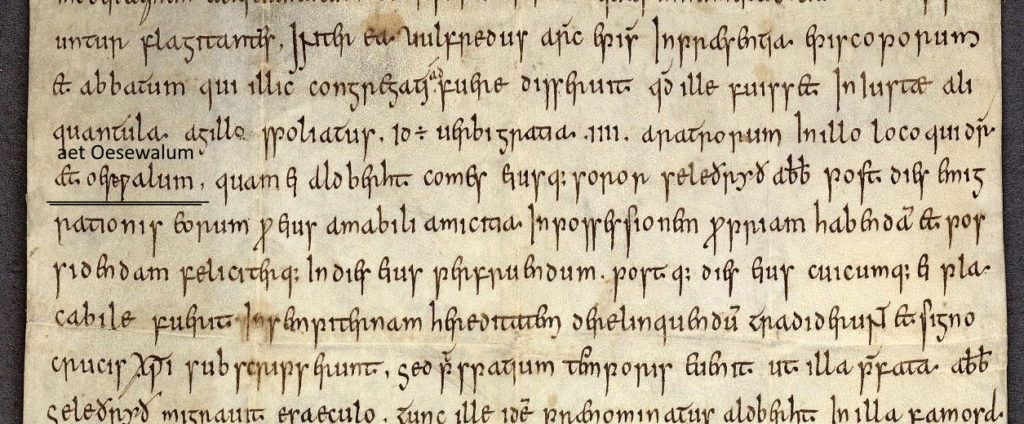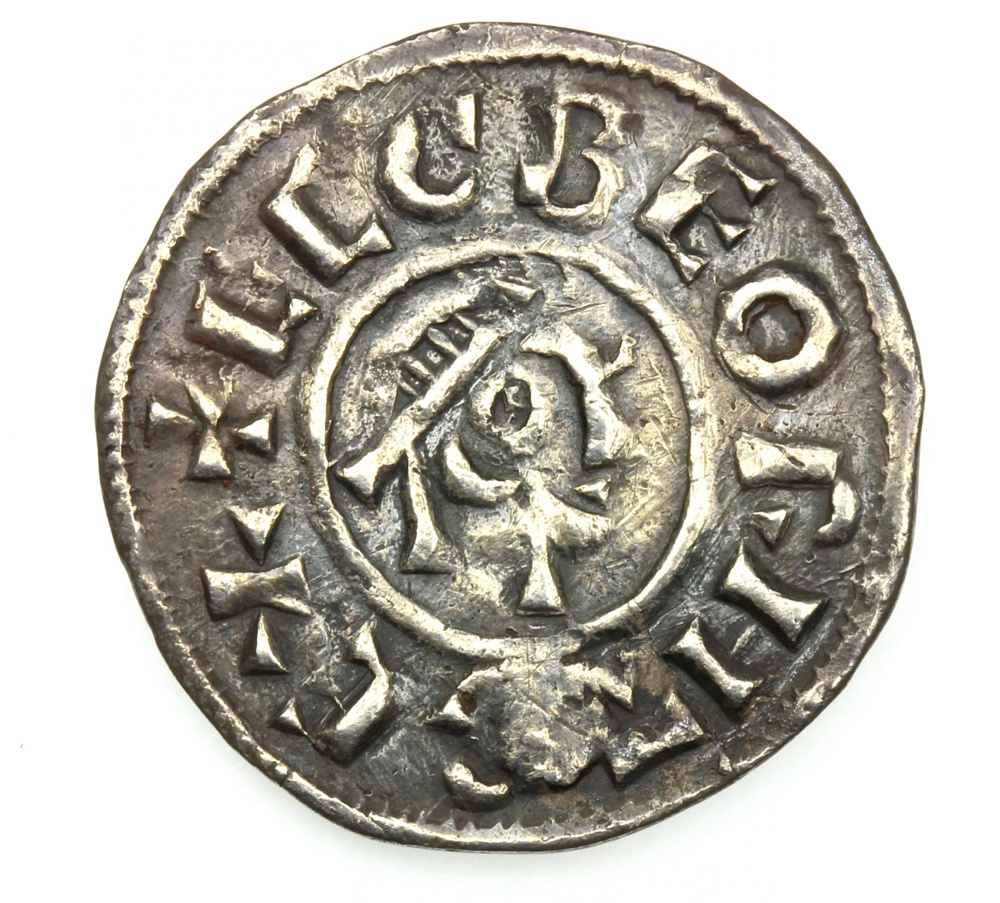The origin of the name Oesewalum [Oeswalum] has been the subject of discussion for many years, J. K. Wallenberg in his “The place-names of Kent” published in 1934, believed the name to derive from ōs or ēs; a deity/deities or semi-deity/deities and walu; a bank or ridge, giving a literal meaning of the ridge or bank of the god(s). Wallenberg appears to be the first scholar to identify Oesewalum as being the modern Easole in Nonington. This identification is now something I would question and I will state my reasons for this later in this article.
Oesewalum would therefore seem to have lain on the south-western boundary of the Hundred of Eastry and the south-eastern boundary of the Hundred of Wingham, and therefore would have been a part of the early kingdom, later a sub-kingdom, of Eastry [East rige-eastern province] which was absorbed into the larger Anglo-Saxon Kingdom of Kent. After two centuries or so as one of the seven most powerful kingdoms in England (the Heptarchy) the independent Kingdom of Kent went into decline in the later part of the eighth century and eventually became a province of the Kingdom of Wessex around 825.
Towards the end of the eighth century Oesewalum, or at least some of the land there, was held by Earl Aldberht [also: Ealdbeorht, Ealdberht], and his sister, Selethryth [also: Seleðryth ,Seleðryð], who abbess of Southminster, or Suthminster, at Minster in Thanet, and also abbess of the minster at Lyminge. The estate at Oesewalum had either been inherited from their father, a Kentish nobleman and land-owner, or granted to them along with other extensive estates by King Offa of Mercia for their support in quelling a Kentish revolt against him during the mid-780′s. Aldbert is recorded on some documents as being a minister or advisor to Offa.
In her role as abbess of Southminster and Lyminge minsters Selethryth had become involved in some long running disputes with the Archbishops of Canterbury dating back to before the death of King Offa of Mercia in 796. In the main part these concerned who had authority over the Kent monastic houses of Southminster [Minster in Thanet], Reculver, and Lyminge and their considerable respective revenues which were under the control of the Mercian kings.
After the death of Archbishop Æthelhard in May of 805 Wulfred (also Uulfred), the Archdeacon of Christ Church in Canterbury, was consecrated Archbishop and continued try to assert control over the Mercian controlled religious houses. To help resolve these disputes Selethryth agreed soon after Wulfred’s consecration to grant the estate at Oesewalum to the new Archbishop with the grant entailing his personal possession of the estate “in sempiternam hereditatem” [in everlasting inheritance] after the deaths of both herself and her brother Aldberht. Selethryth is believed to have died soon after the grant, but Aldberht lived on for many years and eventually entered the monastery at Folkestone, dying there around 820.


After Aldberht’s death his and Selethryth’s interests were inherited by Oswulf, a kinsman of theirs who is referred to the time of Aldberht’s death as an earldorman, a high ranking official who represented the king’s interests. Oswulf seized the deeds to Oesewalum and took them to Southminster where he presented them to Cwoenthryth, the daughter of Coenwulf, King of Mercia and overlord of Kent, who had succeeded Selethryth as the abbess of Southminster and the nearby Reculver minster, which were both under the control of Cwoenthryth’s father as King of Mercia. Both minsters were situated on the Wantsum Channel which then separated the Isle of Thanet from the rest of Kent and had large revenues drawn from sea-borne trade.
Cwoenthryth had a great deal of authority vested in her by father and she became very influential within the Mercian client kingdom of Kent. As Abbess of Southminster and Reculver, she was able to retain possession of Oesewalum for some years under the protection of her father and Ceolwulf, Coenwulf’s brother and actual successor, who succeeded to the Mercian throne in 821. In furtherance of this dispute Coenwulf named Cwoenthryth as his heir to the disputed properties in his will, and Cwoenthryth came in to her inheritance on her father’s death in 821.
Ceolwulf’s reign as “King of the Mercians and of the men of Kent” was short, he was overthrown in 823 by Beornwulf, a man of unknown origins, who made Baldred [Bealdred] the ruler of a Kent over which he could maintain very little authority.
The loss of her family’s protection proved very detrimental to Cwoenthryth in her dispute with Wulfred. Beornwulf, her uncle’s usurper, agreed to resolve the matter of the control and ownership of Southminster and Reculver along with various other manors and estates at the Synods of Cloveshoe of 824 and 825. However, the disputes was not fully resolved as Cwoenthryth withheld payments due to Wulfred and the property was not properly in Wulfred possession until around 827. Oesewalum, referred to in the subsequent charter as Oesuualun, was one of the estates returned to Wulfred and which he continued to own until his death in 832 when it passed by inheritance to his kinsman, Werhard the Priest.

The reference to Oesewalum or Oeswalum [underlined ] concerning Archbishop Wulfred’s recovery of four sulungs (aratra) at Easole, Kent, promised to him by Ealdberht, comes. From the record of the synod of Clofesho of 824.
Stowe Charter 1434-British Library, London
After Wulfred’s legal victory was completed in 827 Cwoenthryth was compelled to give up the offices she held in Kent and she subsequently retired to Winchcombe Abbey in Gloucestershire which had been founded and generously endowed by Coenwulf, who was buried there along with Kenelm, Cwoenthryth’s younger brother.
Work appears to have begun on building the abbey in 798, and it was dedicated by Wulfred, Archbishop of Canterbury, in 811, and Cwoenthryth had been Abbess of Winchcombe since its foundation. After she retired to Winchcombe nothing more was heard of her, presumably she stayed there until her death, the date of which is unknown.
Cwoenthryth is now probably best known from her characterization in the Legend of St. Kenelm, written in the 12th century, where she is apparently unjustifiably portrayed as the scheming sister who arranges her brother Kenelm’s death. This legend has no basis in fact and her portrayal as the villainess of the piece may be because of her long and defiant dispute with Archbishop Wulfred at a time when any challenge to the authority of the church by anyone in authority, never mind by a strong willed women, was considered to be almost a heresy!
An English princess called Kwenthrith, said to be based on Cwenthryth, and played by Amy Bailey appears in the second to fourth seasons of the History Channel historical adventure drama series “Vikings”.
In 825 Beornwulf went to war against Ecgberht, King of Wessex, who defeated Beornwulf at the Battle of Ellandun in Wiltshire and ended Mercia’s supremacy over the other kingdoms of the Anglo-Saxon Heptarchy.
Ecgberht then proceeded to take control of the Mercian dependencies in south-eastern England. In 826 he sent Æthelwulf, his son, to invade Kent and drive out Baldred, its pro-Mercian king, and bring Kent fully under the control of Wessex. In 829 Ecgberht defeated Wiglaf, King of Mercia, taking control of Mercia and ruling it directly, but Ecgberht was unable to maintain this dominant position and within a year Wiglaf had regained the throne of Mercia. However, Wessex retained control of Kent, Sussex, and Surrey and these territories were given to Æthelwulf, Ecgberht’s son, to rule as a sub-king under his father. When Ecgberht died in 839, Æthelwulf succeeded him and the south-eastern kingdoms were absorbed into Wessex after Æthelwulf’s death in 858.


Archbishop Wulfred left a large property portfolio to Werhard the Priest, his kinsman, with the specific instruction that Werhard should in his turn leave the property to Christ Church, Canterbury. Werhard is recorded having become “priest-abbot” of Christ Church in the 830’s and continued to preside over Christ Church until around 845.
Werhard’s will, written in 830, recorded the details of charitable endowments founded by Wulfred to provide for the poor in various manors that he owned along with Wulfred’s instructions to continue with these endowments. The number of beneficiaries varied from manor to manor, at Oesewalum [written as Oesuualun in the will] seven poor people were to be beneficiaries under provisions which specified that “to each one be given daily to eat what may be suitably sufficient and annually to each poor person for clothing 26 pence”. In Werhard’s will Oesewalum is said to be ten hides of land, nominally some 1,000 to 1,200 modern English acres.

The will does not specify who these poor people were, so they could possibly be of any age. If the poor persons referred to were heads of household they would presumably be given enough food to feed their dependents making it possible that upwards of thirty-five people were in daily receipt of food. This would indicate that Oesewalum was a very productive estate and well able to supply the daily bounty to the poor. The Archbishop also required that a mass be celebrated for his soul every day and that on his anniversary 1,200 poor persons should each be given a loaf of bread, some cheese or butter and one penny. This annual bequest amounted to £.5.00 in total, a large sum at a time when an acre of land could be bought for four pence.
After Werhard’s will of 830 there are no known further references to Oesewalum or any variants of the name. Christ Church was given the Manor of Wingham in the late 830’s by Æthelstan, made King of Kent in 839 by his father, King Æthelwulf of Wessex. At the time of the acquisition Werhard was “priest abbot” of Christ Church, and remained as such until his death sometime around 845 when his inherited property was passed on to Christ Church and the estate at Oesewalum was apparently absorbed into the Manor of Wingham and remained a part of it until the manor came into the possession of King Henry VIII some seven hundred years later during the Dissolution of the Monasteries.


This is very interesting and a great website. My ancestry DNA has revealed that I have Scandinavian ancestry so maybe it’s a connection to the Viking invasions. My ancestors lived in Nonington and I would love to find out as much info as possible. They were farmers called The Folwells and lived on Butter Street. My other ancestors were called Rye. If anyone has any info it would be greatly appreciated. One day I will visit Nonington. Denise
Thanks for the portrait, I’ll include it on the site. There is a lot of info online for the Hammonds. There is some research being done locally on the pre-St. Alban’s Hammonds, they appear to have moved from being free-holders at Crixhall in Goodnestone parish to to tenants at St. Alban’s Court. There are mentions of Hammonds going back into the 1300′s in the area around Nonington and possibly Sandwich but no definite genealogy has been established. They appear to have been well-to-do farmers and possibly trades-men.
I love these stories! I appreciate so much my English Heritage and hope to complete as much as possible to the Family Tree. Thank You! I found out I connect to William 1